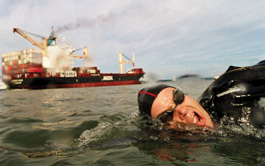home | metro santa cruz index | movies | current reviews | profile

Look Ma, no motor: Christopher Swain submitted himself to a swim that has previously been completed by only salmon and boats.
The Way of the Salmon
Filmmaker's tale of a man's 13-month swim down the Columbia River draws attention to environmental concerns.
By Steve Hahn
Captain Robert Gray, the fur trader who named the Columbia River after his ship Columbia Rediviva in 1792, spent no more than nine days of his life on the river and saw no more than 13 miles of the 1,243-mile waterway before he left the area for good.
Yet his spur-of-the-moment naming stuck, even though the various other names given by indigenous peoples who had spent countless generations living off the river were scattered into the dustbins of history.
This is the simple fact that opens Andy Norris' Source to Sea: The Columbia River Swim, which tells the tale of Christopher Swain, the first man to swim the length of the Columbia.
Viewers will quickly realize this is more than just an ESPN special of personal triumph against overwhelming odds. Norris' montage of archival river footage--overlaid with a voiceover by a member of the "Noisy Water People" speaking in his native tongue--dispatches any vestiges of Eurocentricism with regard to the Pacific North West's "written history" while inviting us to think of the river's history in terms of centuries.
And it doesn't take long for the film to get to the century that might matter most for the river's fate: the 20th.
Swain, it turns out, took on his monumental challenge of human willpower in order to draw attention to the numerous pollution sources that are threatening the future of the salmon and the indigenous human populations that called the river home in previous centuries.
In one scene, the film's subject drives his point home to a group of schoolchildren. "It's like I'm a kid who has had my tricycle broken and it still hasn't been fixed in 30 years," he says, referring to the time since the institution of the Clean Water Act.
"I'm fed up with waiting."
The film continues to follow Swain as he swims each segment of the river, which extends from Canada to Oregon before draining out to the Pacific Ocean. With each section of his trek, a new threat to the waterway and the "weblike ecosystem" it supports reveals itself to the viewer.
The unforeseen effects of the Columbia's 14 dams, some without fish ladders or fish bypass systems, on the salmon population and the native tribes that used the once plentiful fish as a food source, trading commodity and religious icon, is one of the central threats brought up repeatedly in the film.
With the salmon's path blocked, their numbers have decreased in recent years and they have virtually disappeared from some areas of the river. According to wildlife experts interviewed throughout the film, this is problematic not only for the indigenous human populations but also for a "layer of the ecosystem" that relies on the carcasses of salmon.
"You think of Oregon and the Columbia River and you don't think California Condor, but they used to come here for the salmon runs and eat the dying salmon that would come back to their spawning sites," says Norris. "You don't see them around too much anymore. All sorts of animals, from water oozles [small birds], eagles or sturgeon to bears, use salmon for a huge source of food. You bring 60 million fish up a river and you're going to have all sorts of life utilizing those nutrients. If you have an intact river and a full salmon run, you'll have all sorts of creatures there."
The threat to the salmon habitat--further exacerbated by discharges into the river of nuclear waste from a plutonium processing plant, gritty "slag" from a smelting mill, eroded sediment from clear-cut forests and toxic chemicals from a paper mill--is an issue Norris hopes will act as a springboard into discussions of similar environmental problems here in California, including the threatened salmon population in the Klamath River, when he brings the film to Santa Cruz this Friday. It will be only the second showing of the film outside the Columbia Basin.
"You dam up a river and it doesn't matter where you are, you're going to affect the ecology," Norris says. "I kind of framed [the film] so that folks who deal with this all over can learn from it and see what's happened up here."
The film is fairly thorough in showcasing the barrage of threats to the river, but is always sure to cut back to Swain nobly dipping himself in the ice-cold waters just in time to give the viewer a glimmer of hope for the river's future.
Yet, despite the inspiring story of Swain's 13-month-long swim, the film is drenched with a sense of dread for the river's future. With shots of China's notoriously polluted Yangtze River interspersed with those of the Columbia, Norris gestures toward the problematic implications of an unhindered global march toward economic "progress."
"It addresses larger issues outside just the Pacific North West. What is our place in the natural world?" Norris asks Socratically. "People are starting to watch the world disappear and wondering why. They're part of the whole thing. So all that stuff usually gets fleshed out when we do the Q&A at the end."
![]() Source to Sea: The Columbia River Swim plays at the Santa Cruz Vets Hall at 7pm on Friday, April 13. There is a $5 suggested donation.
Source to Sea: The Columbia River Swim plays at the Santa Cruz Vets Hall at 7pm on Friday, April 13. There is a $5 suggested donation.
Send a letter to the editor about this story.
|
|
|
|
|
|